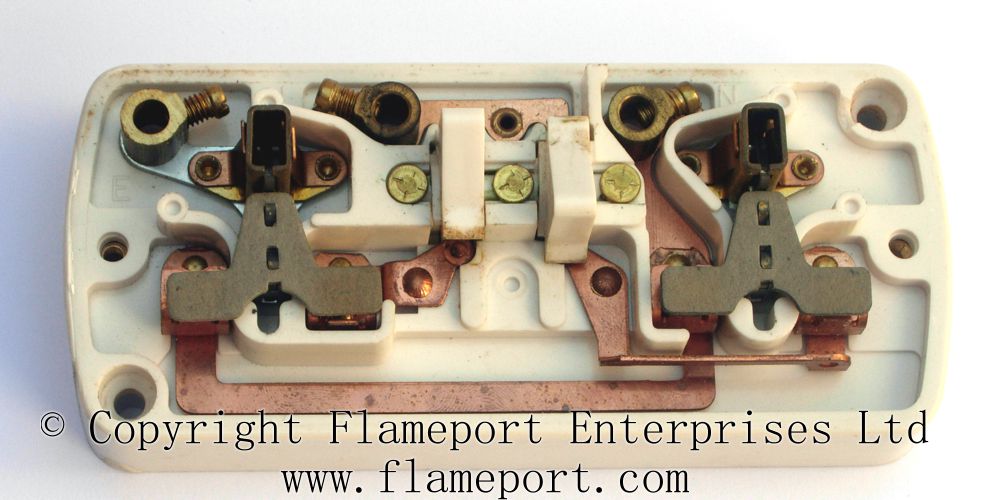Those bits of copper appear chunkier than the copper and brass parts of the MK Logic Plus socket I've just dismantled.
I have just been messing about with a thermal imaging camera and some heavy loads on an MK socket and did some very non scientific tests. The load was a 3.03KW downflow heater in one socket and a 2.2KW and 1KW Kettles in the other socket. Total measured current was 26.5A. Measured voltage was 240V. Load was applied for 10 minutes, by which point my house was getting very warm and I was tried of getting splashed with boiling water from the 2 kettles. Temperatures are all approximate as they were measured using the camera. In the pictures the maximum and minimum temperatures in that current picture is shown at the bottom of each image, the big temperature reading at the top left is the centre of the crosshair.
Observations:
Current flowing through leg 1 of the ring: 5.5A
Current flowing through leg 2 of the ring: 21A
Leg 2 was getting warm, insulation of line conductor was about 45°C.
I broke the ring on the line side and ran the test again for long enough to boil the larger kettle. temperature of the conductors insulation was around 45°C.
The 13A fuses were the main source of heating in all tests, closely followed buy the areas in the socket where the conductor bars carried the current for both outlets. The temperature shown was on the plastic back of the socket, the metal parts inside would be hotter. I should have drilled a hole in the back of the socket and jammed a little temperature probe in there.
Even the fuse in the 2.2KW kettles plug quickly reached around 55°C in the time it took to boil 1.7L of water.
The fuse for the 3.03KW heater quickly reached 65°C in about 2 minutes, but the temperature had not increased after 10 minutes. Tests were run with the lids removed from all plugs which would have provided some cooling. All plugs are quality MK Safetyplugs.
I took the max KW rating of a random TD and a WM and the figure came to about 20A. For a wash and dry cycle run together connected to an MK socket I would expect it to be fine, provided care was taken in relation to the CCC of the spur cable and the refernce method it is installed. With both loads run through a 13A switch fuse, or connected together with a short 2gang extension lead I would expect the fuse not to blow, but to reach temperatures high enough to cause serious damage to the FCU/plug. In the last image I have connected the heater and large kettle (measured current 20.3A) to an extension lead and run it for another 10 minutes. The 13A fuse reached 160°C after around 3 minutes, after 10 minutes the temperature was the same. I had to stop the test as the 0.75mm² flex on the short extension lead was becoming very soft and starting to deform!
The 2 Plugs at the end of the test, shown with their lids removed
The socket face after the test after the plugs were removed.
The rear of the socket after the test (socket upside down with switches at the bottom of the image). The hot areas are above the switches and the 2 bars going down to the wiring terminals.
The top surface at the rear of the socket.
Fuse of extension lead with approx 20A load.
So in conclusion, this experiment has proved fark all, and I'm not running it for 75 hours to see what happens.


